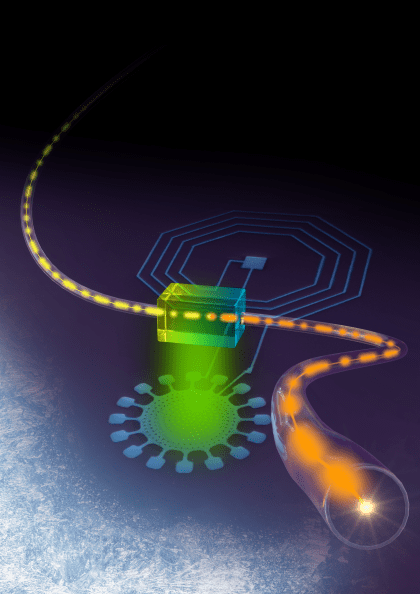
Scientists from the Swiss Federal Institute of Technology Lausanne (EPFL) and the Indian Institute of Science Education and Research have demonstrated that commercially available devices known as electro-optical modulators can be used to read the output of superconducting quantum computers at extremely low temperatures. Using an optical signal instead of an all-electrical approach addresses the high heat-load contribution of electrical components, which is known to reduce the overall efficiency of devices. By demonstrating that an optical system can operate at a fraction of a degree above absolute zero, the result could open a new route to scaling up quantum computers.
Optical fibres transmit light via the highly efficient process of total internal reflection and are widely employed in the telecommunications industry. Because fibre networks carry a great deal of information with low signal losses, they are well suited to transferring data over long distances. As fibre technology improves, these benefits are increasingly being applied to data transfer over shorter distances as well, such as the connections between homes and optical fibre networks and optical connections in chip-scale devices.
Optical components are smaller and lighter than bulky, thermally conductive electrical cables, and their low heat loads make them especially attractive to developers of quantum computers that use superconducting quantum bits (qubits) to store information. At present, these devices require extremely low temperatures to operate, which poses questions about how to add more qubits while managing the thermal contributions of additional components.
Cryogenic electro-optical interconnects
To tackle this problem, Tobias Kippenberg and colleagues developed an integrated optical solution that eliminates the noise associated with the heat-load of electrical components by replacing these components with less thermally conductive optical devices. Currently, electrical amplifiers based on so-called high-electron-mobility transistors are used to read the microwave signal produced by superconducting devices. The new optical approach replaces these amplifiers with off-the-shelf electro-optical modulators, which use an electrical signal to control the phase of light. This means that the microwave signal produced by the superconducting device can be converted to the optical domain to be read at the output.
Crucially, this change enabled the researchers to use optical fibre connections instead of electrical coaxial cables, which were a source of heat in the original system. To realize this benefit, however, the researchers needed to demonstrate that the modulators could operate at the very low temperatures required by the superconducting device. After testing the performance of the modulator down to 800 mK, they showed that the device was indeed suitable as an interconnect between the microwave signal of the superconducting device and an optical detection scheme.
The researchers then compared their new optical design, which they describe in Nature Electronics, with the existing electrical version in two important tests. In the first test, they used coherent microwave spectroscopy, where a laser acts as a mechanical pump to produce a microwave signal in the superconducting device, to confirm that the modulator was able to convert the signal into an optical readout. In the second test, they used the optical modulator to link the superconducting device, which operates at 15 mK, to a room temperature detector. This made it possible to measure the microwave signal produced by the superconducting device directly.

Granular aluminium superinductors could enhance qubit performance
The authors compared the output of the optical device with that of a traditional transistor to show that, whilst there are still improvements to be made in reducing optical noise, the new system nevertheless performs the function of the transistor amplifiers with a vast reduction in heat loss. This result highlights the promise of the optical approach for achieving efficient devices that can provide scalability in superconducting quantum technologies.
A new avenue for scalability
Amir Youseffi, a PhD researcher at EPFL and co-author of the paper, describes the work as “a proof-of-principle experiment using a novel optical readout protocol to optically measure a superconducting device at cryogenic temperatures”. He adds that the design “opens up a new avenue to scale future quantum systems” and says that the next step is to improve the design of the optical modulator, with the aim of reducing the noise the researchers saw in the tested system. This would open the way for scaling the number of qubits achievable in superconducting quantum devices.


